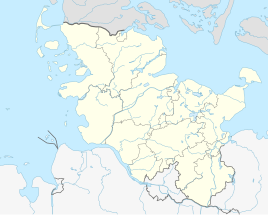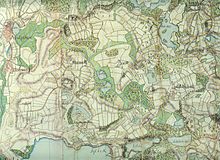Benz (Malente)
|
Benz
Malente municipality
Coordinates: 54 ° 12 ′ 34 ″ N , 10 ° 37 ′ 59 ″ E
|
||
|---|---|---|
| Height : | 64 (51-66) m | |
| Residents : | 386 (Oct 31, 2015) | |
| Postal code : | 23714 | |
| Area code : | 04523 | |
|
Location of Benz in Schleswig-Holstein |
||
Benz is a village in the municipality of Malente in the Ostholstein district in Schleswig-Holstein .
geography
Benz lies in the terminal moraine landscape of Holstein Switzerland . The two Benzer Lakes, i.e. Großer Benzer See and Kleiner Benzer See , are also called Benzer Augen . Geologically, the lakes are two dead ponds that were formed after the last ice age where two huge blocks of glacier ice remained.
District road 1 runs through the village .
history
Settlement of East Holstein after the Ice Age
In Ostholstein , a terminal moraine landscape with hills, lakes, granite rocks and various arable soils was created in the last ice age, the Weichsel ice age . The reindeer hunters were the first inhabitants after the Vistula Ice Age. Archaeological finds of the early inhabitants are hand axes and spearheads made of flint stone. From the time of agriculture we also find millstones, jewelry, bronze parts, traces of settlement, megalithic graves and urn fields . The Germanic Holsten had settled in the area until around AD 600 . In the course of the great migration , the Holsten left Ostholstein. It remained empty for about a century until, from 700 AD, the Slavic Wagrians settled the area from Ostholstein to the south of the Elbe without a fight. Charlemagne later left the area to the also Slavic Abodrites , as they had allied themselves with him in the battle against the Saxons , and agreed with them in 810 AD on the Limes Saxoniae , the border strip of the Slavic settlement area.
The Oldenburg diocese was founded around 970 . Duke Heinrich the Lion gave Wagrien as a fiefdom to Count Adolf II. Von Holstein, who began in 1143 with the settlement of colonists from his domain as well as Westphalia , Flemings , Frisians and Saxony in the central and southern parts of Wagrien . He also tried to promote Christian proselytizing in his domain, in which he was supported by the missionary Vizelin . The Slavic population soon became part of the new majority. Around 1150 Heinrich the Lion promoted Lübeck and the Oldenburg diocese, to which he awarded 300 hooves.
The first documents in 1215
Benz, a Wendish village, was mentioned in 1215/16 as Banzeuiz along with other villages of the Bishop of Lübeck in two documents. In the time after Heinrich the Lion, from 1201, the Battle of Stellau , to 1227, the Battle of Bornhöved , Danish rule extended to the Elbe . King Waldemar II of Denmark appointed his Thuringian nephew Albrecht von Orlamünde as Count of Holstein . The Bishop Bertold of Luebeck asked both the new rulers Waldemar II. And Albrecht of Orlamünde and the Pope Honorius III. to confirm his possessions and rights in Holstein with documents. Benz was one of the villages of the episcopal court in Malente.
In 2015 “800 years of Benz” was celebrated.
The origin of the name Benz
Even today, the names of the villages partly tell us the origin of the settlers: the names Utin and Flehm are Dutch-Flemish. The name Benz is Slavic . The names in the documents of 1215 Banzeuiz and 1251 Benzsche come after Haefs from the old Polish Basevici. The final syllables -vi-ci are a patronymic suffix, i.e. possessive, and Bas is a personal name. The name Bas could also be shortened from Banz or Bansch. So today's place name Benz means: the settlement of the people of Bansch or the village of Banz.
Agriculture in Benz
According to the list of table goods, Benz had 14 Hufner around 1280 . The Hufner had vacant farm positions .
Emperor Charles V raised in 1549 for the parishes Bosau , Neukirchen , Malente, Ratekau , Rensefeld and the country Oldenburg the Empire Turks control . It served to finance the Turkish wars , which have become a constant threat to the emperor and the empire. The Benzer Hufner: Pasker Tamm (today Hof Schulte), Pasker Tode (today Western riding Hof Fraider, Markus Oeverdieck, Lammert Oeverdieck and Hans Oeverdieck were also assessed for this tax .
In the 17th century, the Benzerhof estate gradually emerged from several hooves . The village of Benz belonged to the Benz allodial property in the 19th century . Today the Benzerhof estate is part of Benz.
School and fire department
Before 1836, Benz's first school burned down. It was in poor condition before the fire. The school was on the village pond and the house of the Puls family is now located there. The second school house was built in 1836 on Flehmer Strasse and is currently the village church.
In 1923 the old "Meiereikate" burned at the Benzerhof, later the cowshed, the barn, the former dairy (Hauptstrasse 35) and the owner Lemke's hooves (Schwonauer Weg 2). The arsonist cannot be identified. In 1926 the Benz-Nüchel volunteer fire department was founded. Their first use was in 1934 when the cowshed fire on the Benzerhof . In 1945, independent volunteer fire brigades were founded in Benz and Nüchel. In 1979 a youth fire brigade was founded in the Malente community and the Benz-Nüchel youth fire brigade has existed since 1981.
Church, sports, waterworks, kindergarten
After 1945, a large number of refugees lived in Benz; therefore a church was set up in 1946 for the rapidly growing population in the second schoolhouse built in 1836. The church room is still in use today.
The SV-Benz-Nüchel sports club existed from 1948 to 1957, and TSV-Benz-Nüchel was founded in 1963.
In 1967 the Benz waterworks for the municipality of Malente was put into operation with two 130 m deep wells and approx. 25 km of main lines.
Since 1986 there has been a kindergarten in the village community center, the former school for Benz and Nüchel, which was built in 1938 as the third schoolhouse in Benz.
traffic
Benz had had his own train station since 1890 on the Malente-Gremsmühlen-Lütjenburg railway line, which was completed in 1892 . At the reception building of the railway station there is a memorial plaque for the dissolution of the National Railroad management Stettin , which was held here in July 1945: "command train" the President of the Directorate was stranded here. Since the length of the platform in Benz was insufficient for the train, it had been divided between three stations: Benz, Lensahn and Oldenburg . In 1976 passenger traffic was discontinued, in 1996 goods traffic. From 2006 to 2008 there was a draisine operation between Malente and Lütjenburg .
societies
- Benz volunteer fire department
- Benz-Nüchel gymnastics and sports club in the village community center
Web links
- Village of Benz Dorf-Benz.de
- Benz on Bad-Malente.de
- The place Benz on Malente.de - There is also the note: Benz had 386 inhabitants in Oct. 2015
- TSV-Benz-Nüchel on tsv-benz-nuechel.de
Individual evidence
- ↑ Helmold von Bosau : Slawenchronik , German translation: Book I. Chapter 57 The edification of the city of Lubeke p. 131 below to 133 (PDF) the Latin original text: Capitulum LVII p. 111.
- ↑ a b Helmut Grieser, in the village chronicle. Elke and Heinz Penkert: Benz - A home story . 2007, p. 3.
- ^ Ulrich Pohle, in: Yearbook of the Eutin District , 1968, pp. 26–28.
- ^ Gerhard Stalling: Document Book of the City of Lübeck II. Dept. 1856 Documents XXIX, XXX and XXXI . Place names such as Utin ( Eutin ), Bosowe ( Bosau ), Noua Ecclesia ( Neukirchen ), Melente (Malente), Malkeuiz ( Malkwitz ), Banzeuiz = Bansceuiz (Benz) and Syuredestorp ( Sieversdorf ) can be found in the documents XXX and XXXI .
- ↑ Hanswilhelm Haefs : Place names and local stories in Schleswig-Holstein… 2004, p. 68. For explanation: aplb. = Old Polish = Polabian is the name given to the languages of the West Slavic tribes that have settled in what is now northeastern Germany and northwestern Poland since the 7th century.
- ^ Helmut Grieser: Benz and 775 years of imperial history . In: Issue for the 775th anniversary of Benz in 1990, also printed in the village chronicle: Elke and Heinz Penkert: Benz - A local history . 2007, p. 3 and on dorf-benz.de
- ↑ Western riding in Benz at the Fraider farm )
- ↑ Document in the Schleswig-Holstein State Archives in the Prinzenpalais in Schleswig , there: Section 268, No. 226
- ↑ Lothar Estl, in: Yearbook of History . Eutin 1976, pp. 87-94.
- ↑ a b c d e f g Elke and Heinz Penkert: Benz - A local history . Village chronicle, 2007.
- ↑ John v. Schröder: Topography of the Duchy of Holstein and the Principality of Lübeck and the free and Hanseatic cities of Hamburg and Lübeck . 1841, p. 44. Only the article on Benz - Article on Benz printed in GenWiki
- ↑ Information and photos on Benz IG Eisenbahn station in Lütjenburg 2011
- ^ Ingeborg Jeschke: On the run with the command train. In: Stettiner Bürgerbrief. No. 32 (2006), ISSN 1619-6201 , pp. 59-60.
- ↑ Achim Bartoschek: Railroad cycling - Draisine routes in Germany.

